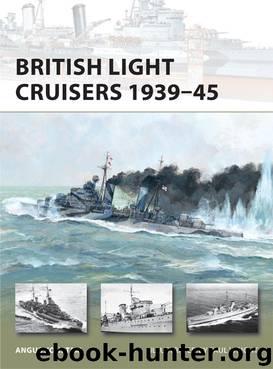British Light Cruisers 1939-45 by Angus Konstam

Author:Angus Konstam
Language: eng
Format: epub
Tags: British Light Cruisers 1939–45
ISBN: 9781782003076
Publisher: Osprey Publishing
The Fiji class cruiser HMS Jamaica, pictured in Scapa Flow in June 1943. That December she took part in the battle of North Cape, operating in consort with Belfast and Sheffield. This camouflage pattern was retained until late 1944.
Fiji Class
The Second London Naval Treaty was signed in March 1936, the signatories being Great Britain, the United States and France. Both Japan and Italy withdrew from the negotiations, and so weren’t bound by its terms. By this time Germany was also becoming a rising naval power again, having disregarded the naval limits imposed on her by the Treaty of Versailles of 1919. The main effect of the treaty was that the powers that would soon form the Western Allies were imposing restrictions on themselves, but not on the powers that would soon become their enemies.
Under the terms of the treaty, cruiser displacement was limited to 8,000 tons with a maximum gun size of 6.1 inches. This meant there would be no repeats of the Southampton or Edinburgh classes, so for any future light cruisers the DNC had to find a way to incorporate the firepower and performance of these earlier vessels into a ship with a smaller displacement. Various configurations were considered, including vessels with multiple 5.25-inch guns, and quadruple turrets, which had recently been developed for the 14-inch guns of the King George V class battleship. Eventually the same gun configuration as the earlier 6-inch classes was selected and, to save weight, armoured protection was considerably reduced. The result was the Fiji class of light cruiser.
The hulls of these ships were shorter and narrower than their predecessors of the Southampton class and they had a squared-off transom stern compared to the rounded stern of the earlier cruisers. To save weight even further, no torpedo tubes or quadruple 2-pdr ‘pom-poms’ were fitted, although space was left for them to be added. Similarly, only one main battery Director Control Tower (DCT) was fitted aft, matched by a HACS director mounted above the bridge that was used to control anti-aircraft fire. The only area where compromises were not made was in the armament and the propulsion systems, both of which were the equal of the earlier class. This in turn made the cruisers top heavy, a problem that had to be addressed during the war.
HMS CLEOPATRA AT THE SECOND BATTLE OF SIRTE, 1942
In March 1942 the Dido class anti-aircraft cruiser HMS Cleopatra served as the flagship of Rear-Admiral Vian, who was charged with escorting a convoy from Alexandria to Malta, passing through the enemy-controlled waters of the central Mediterranean. On 22 March Vian’s escorts clashed with a powerful Italian surface group, which included a battleship and several cruisers. The most powerful warships at Vian’s disposal were his flagship Cleopatra and three other light cruisers. Vian attacked the enemy, buying time for the convoy to evade the Italians. In the action that followed Cleopatra was badly damaged, but after 2½ hours of fighting the Italian fleet withdrew and the convoy continued its journey to Malta, although two of its four cargo ships were sunk by air attack before it reached port.
Download
This site does not store any files on its server. We only index and link to content provided by other sites. Please contact the content providers to delete copyright contents if any and email us, we'll remove relevant links or contents immediately.
| Africa | Americas |
| Arctic & Antarctica | Asia |
| Australia & Oceania | Europe |
| Middle East | Russia |
| United States | World |
| Ancient Civilizations | Military |
| Historical Study & Educational Resources |
Flight by Elephant(1481)
The Rise and Fall of the Third Reich: A History of Nazi Germany by William L. Shirer(1384)
Unbroken: A World War II Story of Survival, Resilience, and Redemption by Hillenbrand Laura(1100)
German submarine U-1105 'Black Panther' by Aaron Stephan Hamilton(1018)
Last Hope Island by Lynne Olson(934)
A Bridge Too Far by Cornelius Ryan(928)
The Victors - Eisenhower and His Boys The Men of World War II by Stephen E. Ambrose(904)
War by Unknown(904)
The Guns at Last Light: The War in Western Europe, 1944-1945 by Rick Atkinson(887)
Rogue Heroes: The History of the SAS, Britain's Secret Special Forces Unit That Sabotaged the Nazis and Changed the Nature of War by Ben Macintyre(884)
0060740124.(F4) by Robert W. Walker(872)
The Hitler Options: Alternate Decisions of World War II by Kenneth Macksey(865)
The Railway Man by Eric Lomax(847)
All the Gallant Men by Donald Stratton(815)
Hitler's Vikings by Jonathan Trigg(808)
A Tragedy of Democracy by Greg Robinson(800)
Churchill's Secret War by Madhusree Mukerjee(797)
Hitler's Armies by Chris McNab(781)
We Die Alone: A WWII Epic of Escape and Endurance by David Howarth & Stephen E. Ambrose(745)
